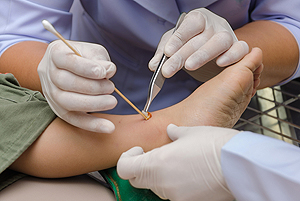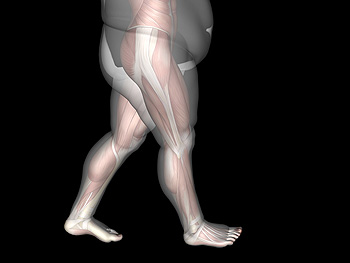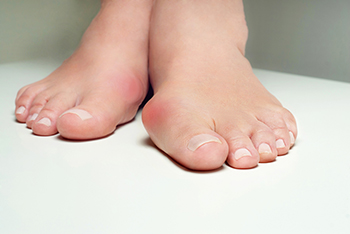Connect With Us
Blog
Items filtered by date: March 2021
How Do I Prevent Diabetic Foot Ulcers?
 If you are diabetic, then you’ve likely heard about diabetic foot ulcers (DFUs). DFUs are wounds that form on the feet and heal poorly and very slowly. Because diabetes is associated with a loss of sensation and poor circulation in the feet, you may not feel these wounds when they first form. DFUs can develop anywhere on the feet or toes, but they most frequently appear on the soles of the feet, where they often go unnoticed until they produce symptoms such as fluid drainage. To avoid a surprising and painful discovery on the bottoms of your feet, it is important to take preventive measures. Wash your feet daily in warm, soapy water and dry them thoroughly. Moisturize the bottoms of the feet to avoid dry skin, which can crack and lead to wounds. Inspect your feet daily for any abnormalities, including new cuts, scrapes, sores, pain, or discoloration. If you find anything unusual, consult with a podiatrist as soon as possible.
If you are diabetic, then you’ve likely heard about diabetic foot ulcers (DFUs). DFUs are wounds that form on the feet and heal poorly and very slowly. Because diabetes is associated with a loss of sensation and poor circulation in the feet, you may not feel these wounds when they first form. DFUs can develop anywhere on the feet or toes, but they most frequently appear on the soles of the feet, where they often go unnoticed until they produce symptoms such as fluid drainage. To avoid a surprising and painful discovery on the bottoms of your feet, it is important to take preventive measures. Wash your feet daily in warm, soapy water and dry them thoroughly. Moisturize the bottoms of the feet to avoid dry skin, which can crack and lead to wounds. Inspect your feet daily for any abnormalities, including new cuts, scrapes, sores, pain, or discoloration. If you find anything unusual, consult with a podiatrist as soon as possible.
Diabetic foot care is important in preventing foot ailments such as ulcers. If you are suffering from diabetes or have any other concerns about your feet, contact Dr. Michael D. Garvin from Florida. Our doctor can provide the care you need to keep you pain-free and on your feet.
Diabetic Foot Care
Diabetes affects millions of people every year. The condition can damage blood vessels in many parts of the body, especially the feet. Because of this, taking care of your feet is essential if you have diabetes, and having a podiatrist help monitor your foot health is highly recommended.
The Importance of Caring for Your Feet
- Routinely inspect your feet for bruises or sores.
- Wear socks that fit your feet comfortably.
- Wear comfortable shoes that provide adequate support.
Patients with diabetes should have their doctor monitor their blood levels, as blood sugar levels play such a huge role in diabetic care. Monitoring these levels on a regular basis is highly advised.
It is always best to inform your healthcare professional of any concerns you may have regarding your feet, especially for diabetic patients. Early treatment and routine foot examinations are keys to maintaining proper health, especially because severe complications can arise if proper treatment is not applied.
If you have any questions please feel free to contact our offices located in Port St. Lucie, FL . We offer the newest diagnostic and treatment technologies for all your foot and ankle needs.
Read more about Diabetic Foot CareHow Do I Prevent Diabetic Foot Ulcers?
 If you are diabetic, then you’ve likely heard about diabetic foot ulcers (DFUs). DFUs are wounds that form on the feet and heal poorly and very slowly. Because diabetes is associated with a loss of sensation and poor circulation in the feet, you may not feel these wounds when they first form. DFUs can develop anywhere on the feet or toes, but they most frequently appear on the soles of the feet, where they often go unnoticed until they produce symptoms such as fluid drainage. To avoid a surprising and painful discovery on the bottoms of your feet, it is important to take preventive measures. Wash your feet daily in warm, soapy water and dry them thoroughly. Moisturize the bottoms of the feet to avoid dry skin, which can crack and lead to wounds. Inspect your feet daily for any abnormalities, including new cuts, scrapes, sores, pain, or discoloration. If you find anything unusual, consult with a podiatrist as soon as possible.
If you are diabetic, then you’ve likely heard about diabetic foot ulcers (DFUs). DFUs are wounds that form on the feet and heal poorly and very slowly. Because diabetes is associated with a loss of sensation and poor circulation in the feet, you may not feel these wounds when they first form. DFUs can develop anywhere on the feet or toes, but they most frequently appear on the soles of the feet, where they often go unnoticed until they produce symptoms such as fluid drainage. To avoid a surprising and painful discovery on the bottoms of your feet, it is important to take preventive measures. Wash your feet daily in warm, soapy water and dry them thoroughly. Moisturize the bottoms of the feet to avoid dry skin, which can crack and lead to wounds. Inspect your feet daily for any abnormalities, including new cuts, scrapes, sores, pain, or discoloration. If you find anything unusual, consult with a podiatrist as soon as possible.
Diabetic foot care is important in preventing foot ailments such as ulcers. If you are suffering from diabetes or have any other concerns about your feet, contact Dr. Michael D. Garvin from Florida. Our doctor can provide the care you need to keep you pain-free and on your feet.
Diabetic Foot Care
Diabetes affects millions of people every year. The condition can damage blood vessels in many parts of the body, especially the feet. Because of this, taking care of your feet is essential if you have diabetes, and having a podiatrist help monitor your foot health is highly recommended.
The Importance of Caring for Your Feet
- Routinely inspect your feet for bruises or sores.
- Wear socks that fit your feet comfortably.
- Wear comfortable shoes that provide adequate support.
Patients with diabetes should have their doctor monitor their blood levels, as blood sugar levels play such a huge role in diabetic care. Monitoring these levels on a regular basis is highly advised.
It is always best to inform your healthcare professional of any concerns you may have regarding your feet, especially for diabetic patients. Early treatment and routine foot examinations are keys to maintaining proper health, especially because severe complications can arise if proper treatment is not applied.
If you have any questions please feel free to contact our offices located in Port St. Lucie, FL . We offer the newest diagnostic and treatment technologies for all your foot and ankle needs.
Does Laser Treatment for Toenail Fungus Work?
The technology behind laser treatments that correct other conditions within the body such as cataracts and gum disease can also be used to remove toenail fungus (onychomycosis). During this painless form of treatment, a laser is aimed exactly at the microorganisms under the nail to eliminate them with no damage to healthy tissue in the area. Laser treatment for fungal nails is accurate and painless and can take as little as ten minutes per toe—as opposed to the weeks or months needed for topical or oral treatments to work. What’s more, those other treatments aren’t always as successful as lasers are in removing or preventing the fungi from returning. End the embarrassment of toenail fungus for good by calling a podiatrist who can quickly remove your toenail fungi and get your toes looking great again.
If left untreated, toenail fungus may spread to other toenails, skin, or even fingernails. If you suspect you have toenail fungus it is important to seek treatment right away. For more information about treatment, contact Dr. Michael D. Garvin of Florida. Our doctor can provide the care you need to keep you pain-free and on your feet.
Symptoms
- Warped or oddly shaped nails
- Yellowish nails
- Loose/separated nail
- Buildup of bits and pieces of nail fragments under the nail
- Brittle, broken, thickened nail
Treatment
If self-care strategies and over-the-counter medications does not help your fungus, your podiatrist may give you a prescription drug instead. Even if you find relief from your toenail fungus symptoms, you may experience a repeat infection in the future.
Prevention
In order to prevent getting toenail fungus in the future, you should always make sure to wash your feet with soap and water. After washing, it is important to dry your feet thoroughly especially in between the toes. When trimming your toenails, be sure to trim straight across instead of in a rounded shape. It is crucial not to cover up discolored nails with nail polish because that will prevent your nail from being able to “breathe”.
In some cases, surgical procedure may be needed to remove the toenail fungus. Consult with your podiatrist about the best treatment options for your case of toenail fungus.
If you have any questions, please feel free to contact our offices located in Port St. Lucie, FL . We offer the newest diagnostic and treatment technologies for all your foot care needs.
Read more about How to Treat Your Toenail Fungus
Reminder: When Was the Last Time...?
Reminder: When Was the Last Time...?
Can Being Overweight Damage My Feet?
 Being overweight by even 25 pounds can put extra stress on your feet and make you more susceptible to developing conditions like tendinitis, osteoarthritis, and plantar fasciitis. Obesity—identified as having a body mass index (BMI) of 30 or higher—can lead to even bigger, more painful and potentially dangerous foot conditions brought on by diabetes, gout, and peripheral heart disease. Losing weight through diet and low-impact exercise is one of the best ways to keep your feet and ankles healthy. However, this can be challenging or even risky for those with a foot or ankle issue. Ask your podiatrist to recommend physical activities that are safe for you, and proper footwear to support your feet and avoid injury.
Being overweight by even 25 pounds can put extra stress on your feet and make you more susceptible to developing conditions like tendinitis, osteoarthritis, and plantar fasciitis. Obesity—identified as having a body mass index (BMI) of 30 or higher—can lead to even bigger, more painful and potentially dangerous foot conditions brought on by diabetes, gout, and peripheral heart disease. Losing weight through diet and low-impact exercise is one of the best ways to keep your feet and ankles healthy. However, this can be challenging or even risky for those with a foot or ankle issue. Ask your podiatrist to recommend physical activities that are safe for you, and proper footwear to support your feet and avoid injury.
The more you weigh, the harder your feet must work to support your body. If you’re an obese individual and are concerned about your feet, contact Dr. Michael D. Garvin from Florida. Our doctor can provide the care you need to keep you pain-free and on your feet.
Obesity and Your Feet
People who are overweight are putting more pressure on their ankles, knees, and hips as well as their feet. This unfortunately can lead to variety of different issues.
Problems & Complications Stemming from Obesity
- When the body is overweight, it tries to compensate by changing the way that it moves. An obese person may lean forward and put extra weight on the wrong part of the foot. This puts unnecessary stress on the feet.
- Obese people are also more likely to develop type II diabetes which is a condition that causes a lot of foot problems. People with diabetes often don’t feel the cuts and sores that they may have on their feet, which can lead to more complicated and severe issues.
- Plantar fasciitis is another foot condition that can be caused by obesity. Plantar fasciitis is an inflammation of the tissue along the bottom of the foot, which causes pain and stiffness while walking and climbing stairs.
If you have any questions, please feel free to contact our offices located in Port St. Lucie, FL . We offer the newest diagnostic and treatment technologies for all your foot care needs.
Read more about How Obesity Affects Your FeetBunion Exercises
 A bunion is described as a bony protrusion that forms on the side of the big toe. Many patients experience pain and discomfort from this ailment, and it may gradually worsen. It can happen as a result of genetic factors, or from wearing shoes that do not have adequate room for the toes to move freely in. The muscles can become weakened, and it is beneficial to perform specific foot stretches that may help to strengthen the affected area and overall foot. A foot scrunch helps to improve dexterity when performed regularly. This is done by placing a towel on the floor, and lifting it up with your foot. Toe yoga helps to improve mobility in the toes, which may positively affect general balance in the body. If you have developed a bunion, it is strongly suggested that you speak with a podiatrist who can offer you additional exercise and treatment options that are right for you.
A bunion is described as a bony protrusion that forms on the side of the big toe. Many patients experience pain and discomfort from this ailment, and it may gradually worsen. It can happen as a result of genetic factors, or from wearing shoes that do not have adequate room for the toes to move freely in. The muscles can become weakened, and it is beneficial to perform specific foot stretches that may help to strengthen the affected area and overall foot. A foot scrunch helps to improve dexterity when performed regularly. This is done by placing a towel on the floor, and lifting it up with your foot. Toe yoga helps to improve mobility in the toes, which may positively affect general balance in the body. If you have developed a bunion, it is strongly suggested that you speak with a podiatrist who can offer you additional exercise and treatment options that are right for you.
If you are suffering from bunion pain, contact Dr. Michael D. Garvin of Florida. Our doctor can provide the care you need to keep you pain-free and on your feet.
What Is a Bunion?
Bunions are painful bony bumps that usually develop on the inside of the foot at the joint of the big toe. As the deformity increases over time, it may become painful to walk and wear shoes. Women are more likely to exacerbate existing bunions since they often wear tight, narrow shoes that shift their toes together. Bunion pain can be relieved by wearing wider shoes with enough room for the toes.
Causes
- Genetics – some people inherit feet that are more prone to bunion development
- Inflammatory Conditions - rheumatoid arthritis and polio may cause bunion development
Symptoms
- Redness and inflammation
- Pain and tenderness
- Callus or corns on the bump
- Restricted motion in the big toe
In order to diagnose your bunion, your podiatrist may ask about your medical history, symptoms, and general health. Your doctor might also order an x-ray to take a closer look at your feet. Nonsurgical treatment options include orthotics, padding, icing, changes in footwear, and medication. If nonsurgical treatments don’t alleviate your bunion pain, surgery may be necessary.
If you have any questions, please feel free to contact our offices located in Port St. Lucie, FL . We offer the newest diagnostic and treatment technologies for all your foot care needs.
Read more about BunionsBunion Exercises
 A bunion is described as a bony protrusion that forms on the side of the big toe. Many patients experience pain and discomfort from this ailment, and it may gradually worsen. It can happen as a result of genetic factors, or from wearing shoes that do not have adequate room for the toes to move freely in. The muscles can become weakened, and it is beneficial to perform specific foot stretches that may help to strengthen the affected area and overall foot. A foot scrunch helps to improve dexterity when performed regularly. This is done by placing a towel on the floor, and lifting it up with your foot. Toe yoga helps to improve mobility in the toes, which may positively affect general balance in the body. If you have developed a bunion, it is strongly suggested that you speak with a podiatrist who can offer you additional exercise and treatment options that are right for you.
A bunion is described as a bony protrusion that forms on the side of the big toe. Many patients experience pain and discomfort from this ailment, and it may gradually worsen. It can happen as a result of genetic factors, or from wearing shoes that do not have adequate room for the toes to move freely in. The muscles can become weakened, and it is beneficial to perform specific foot stretches that may help to strengthen the affected area and overall foot. A foot scrunch helps to improve dexterity when performed regularly. This is done by placing a towel on the floor, and lifting it up with your foot. Toe yoga helps to improve mobility in the toes, which may positively affect general balance in the body. If you have developed a bunion, it is strongly suggested that you speak with a podiatrist who can offer you additional exercise and treatment options that are right for you.
If you are suffering from bunion pain, contact Dr. Michael D. Garvin of Florida. Our doctor can provide the care you need to keep you pain-free and on your feet.
What Is a Bunion?
Bunions are painful bony bumps that usually develop on the inside of the foot at the joint of the big toe. As the deformity increases over time, it may become painful to walk and wear shoes. Women are more likely to exacerbate existing bunions since they often wear tight, narrow shoes that shift their toes together. Bunion pain can be relieved by wearing wider shoes with enough room for the toes.
Causes
- Genetics – some people inherit feet that are more prone to bunion development
- Inflammatory Conditions - rheumatoid arthritis and polio may cause bunion development
Symptoms
- Redness and inflammation
- Pain and tenderness
- Callus or corns on the bump
- Restricted motion in the big toe
In order to diagnose your bunion, your podiatrist may ask about your medical history, symptoms, and general health. Your doctor might also order an x-ray to take a closer look at your feet. Nonsurgical treatment options include orthotics, padding, icing, changes in footwear, and medication. If nonsurgical treatments don’t alleviate your bunion pain, surgery may be necessary.
If you have any questions, please feel free to contact our offices located in Port St. Lucie, FL . We offer the newest diagnostic and treatment technologies for all your foot care needs.
Cracked Heels During Pregnancy
 Many pregnant women notice cracked heels have developed over the course of their pregnancy. This can happen for a variety of reasons, including because of the added weight the heels must endure, hormonal changes, and changes in gait. Patients have found relief when the feet are soaked in warm water, followed by applying a good moisturizer on the entire foot. Having a pedicure performed is an effective method to alleviate cracked heels, which can include using a pumice stone to soften the dry skin. It is important to take proper care of your feet while pregnant, and if you would like additional information on how to achieve this, please consult with a podiatrist who can address any concerns you may have.
Many pregnant women notice cracked heels have developed over the course of their pregnancy. This can happen for a variety of reasons, including because of the added weight the heels must endure, hormonal changes, and changes in gait. Patients have found relief when the feet are soaked in warm water, followed by applying a good moisturizer on the entire foot. Having a pedicure performed is an effective method to alleviate cracked heels, which can include using a pumice stone to soften the dry skin. It is important to take proper care of your feet while pregnant, and if you would like additional information on how to achieve this, please consult with a podiatrist who can address any concerns you may have.
If the skin on your feet starts to crack, you may want to see a podiatrist to find treatment. If you have any concerns, contact Dr. Michael D. Garvin from Florida. Our doctor can provide the care you need to keep you pain-free and on your feet.
Cracked Heels
It is important to moisturize your cracked heels in order to prevent pain, bleeding, and infection. The reason cracked heels form is because the skin on the foot is too dry to support the immense pressure placed on them. When the foot expands, the dry skin on the foot begins to split.
Ways to Help Heal Them
- Invest in a good foot cream
- Try Using Petroleum Jelly
- Ease up on Soaps
- Drink Plenty of Water
Ways to Prevent Cracked Heels
- Moisturize After Showering
- Skip a Shower
- Keep Shower Water Lukewarm
- Don’t Scrub Your Feet
If you are unsure how to proceed in treating cracked heels, seek guidance from a podiatrist. Your doctor will help you with any questions or information you may need.
If you have any questions, please feel free to contact our offices located in Port St. Lucie, FL . We offer the newest diagnostic and treatment technologies for all your foot care needs.
Read more about Solutions for Cracked HeelsBlog Archives
- April 2025
- March 2025
- February 2025
- January 2025
- December 2024
- November 2024
- October 2024
- September 2024
- August 2024
- July 2024
- June 2024
- May 2024
- April 2024
- March 2024
- February 2024
- January 2024
- December 2023
- November 2023
- October 2023
- September 2023
- August 2023
- July 2023
- June 2023
- May 2023
- April 2023
- March 2023
- February 2023
- January 2023
- December 2022
- November 2022
- October 2022
- September 2022
- August 2022
- July 2022
- June 2022
- May 2022
- April 2022
- March 2022
- February 2022
- January 2022
- December 2021
- November 2021
- October 2021
- September 2021
- August 2021
- July 2021
- June 2021
- May 2021
- April 2021
- March 2021
- February 2021
- January 2021
- December 2020
- November 2020
- October 2020
- September 2020
- August 2020
- July 2020
- June 2020
- May 2020
- April 2020
- March 2020
- February 2020
- January 2020
- December 2019
- November 2019
- October 2019
- September 2019
- August 2019
- July 2019
- June 2019
- May 2019
- April 2019
- March 2019
- February 2019
- January 2019
- December 2018
- November 2018
- October 2018
- September 2018
- August 2018
- July 2018
- June 2018
- May 2018
- April 2018
- March 2018
- February 2018
- January 2018
- December 2017
- November 2017
- October 2017
- September 2017
- August 2017
- July 2017
- June 2017
- May 2017
- April 2017
- March 2017
- February 2017
- January 2017
- December 2016
- November 2016
- October 2016
- September 2016
- August 2016



